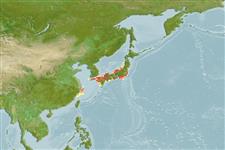>
Gobiiformes (Gobies) >
Gobiidae (Gobies) > Gobiinae
Etymology: Platygobiopsis: Greek, platys = flat + Latin, gobius = gudgeon + Greek, opsis = appearance (Ref. 45335); tansei: Named 'Tansei' for the research vessel Tanseimaru of the Ocean Research Institute, University of Tokyo (or Japan Marine Science and Technology Center) for collecting many Suruga Bay specimens including the holotype; noun in apposition.
Eponymy: ‘Tansei Maru’ is the name of a research vessel, owned by the Ocean Research Institute, University of Tokyo (now Japan Marine Science and Technology Center), which was responsible for collecting the holotypes of the goby and false brotula. (Ref. 128868), visit book page.
Environment: milieu / climate zone / depth range / distribution range
Ecologia
marino demersale; distribuzione batimetrica 60 - 136 m (Ref. 75206). Temperate
Distribuzione
Stati | Aree FAO | Ecosystems | Presenze | Point map | Introduzioni | Faunafri
Northwest Pacific: Japan.
Size / Peso / Age
Maturity: Lm ? range ? - ? cm
Max length : 4.7 cm SL maschio/sesso non determinato; (Ref. 75206)
Short description
Chiavi di identificazione | Morfologia | Morfometria
Spine dorsali (totale) : 7; Raggi dorsali molli (totale) : 13 - 14; Spine anali: 1; Raggi anali molli: 12 - 14; Vertebre: 26. This species is distinguished by the following characters: D VI, I, 13-14; outer gill rakers on first gill arch 0+9-10; no chin barbel; predorsal scales reaching anteriorly to transverse line through middle of operculum; no scales from pectoral-fin base; cephalic sensory-canal pores absent; pelvic-fin frenum absent (Ref. 75206).
A true benthic species in the sloping sandy mud bottoms, often residing in the bottom sediment itself. In Suruga Bay, P. tansei was often found in beam trawl collections containing a lot of sandy mud sediments, probably due to the less than flat bottom configuration of the habitat (Ref. 75206).
Life cycle and mating behavior
Maturità | Riproduzione | Deposizione | Uova | Fecundity | Larve
Okiyama, M., 2008. Platygobiopsis tansei, a new species of dorso-ventrally flattened gobiid fish from Southern Japan. Bull. Natl. Mus. Nat. Sci. Ser. A. Suppl. 2:85-96. (Ref. 75206)
IUCN Red List Status (Ref. 130435: Version 2024-2)
Threat to humans
Harmless
Human uses
Strumenti
Special reports
Download XML
Fonti Internet
Estimates based on models
Phylogenetic diversity index (Ref.
82804): PD
50 = 0.6250 [Uniqueness, from 0.5 = low to 2.0 = high].
Bayesian length-weight: a=0.01023 (0.00477 - 0.02194), b=3.01 (2.83 - 3.19), in cm total length, based on LWR estimates for this (Sub)family-body shape (Ref.
93245).
Trophic level (Ref.
69278): 3.2 ±0.3 se; based on size and trophs of closest relatives
Resilienza (Ref.
120179): Alto, tempo minimo di raddoppiamento della popolazione meno di 15 mesi (Preliminary K or Fecundity.).
Fishing Vulnerability (Ref.
59153): Low vulnerability (10 of 100).
